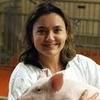Explore all the information on
Swine biosecurity
Biosecurity of pigs at the farm level is the set of practical measures taken to prevent entrance of infection into a pig farm and control the spread of infection within that farm. The goal of a biosecurity program is to keep out pathogens that the herd has not been exposed to and to minimize the impact of endemic pathogens. Pig farm security can be defined as the planning and implementation of a program to minimize various types of risk that can have detrimental effects on the farmstead and pigs. Biosecurity and security procedures are intertwined to enhance the health and productivity of pigs. Numerous factors are involved in the development and maintenance of a cost-effective program for biosecurity. These factors can be thought of as links in a chain; a biosecurity program is only as strong as its weakest link.
ll farm biosecurity and security risk factors are unique to that farm and, thus, each biosecurity plan should be farm specific. The best plans are created by working with a swine veterinarian or veterinary consultant who has extensive knowledge of the farm, employees, and local risk factors.
The application of biosecurity measures differs among farms due to the geographic location of the farm, proximity to other pig farms, epidemiological situation (causes, distribution, and control of disease in the herd), type of swine operation, level of technology used for production, and whether other people are employed on the farm.
1. Introduction The first set of cases of African swine fever (ASF) in Latvia were detected in the wild boar population at the eastern border with Belarus in June 2014 [1–3]. The disease continued to spread over most of the territory of Latvia within the following years [4–6]. Similar to other ASF affected countries, the infection cycle is maintained by wild boar and this remains a permanent threat for the domestic pig industry [1,7,8]. In parallel, to the epidemic...
Comments : 1
Recommendations: 1
It is well known that heat stress or disease stress during gestation and lactation reduces sow herd productivity and profitability. Lactating sows need a high feed intake to maintain their body condition and to support milk...
Comments : 0
Recommendations: 0
Plasma is comprised of a complex mixture of functional proteins that have a profound, positive impact on animals. Consumed orally, functional proteins help the immune system to respond more quickly and efficiently. This helps animals to...
Comments : 0
Recommendations: 0
In a recent panel with Farm Journal, three experts shared their insights on African Swine Fever and the lessons learned from the effects of the ongoing COVID-19 pandemic.
Gordon Spronk (President of Pipestone Veterinary Services) mentioned that “ASF continues to spread across the globe. It was a threat when it was found in the world’s largest swine population in China and continues to be a threat now.”
Spronk added: “Our vision is to keep it out of our...
Comments : 0
Recommendations: 0
1. Introduction African swine fever (ASF), a fatal disease in domestic pigs and wild boar, has become a serious economic threat to the pig farming sector with global ramifications, more than ever underlined by the recent spread to China, Mongolia and Southeast Asia [1]. It is causing tremendous losses in the industrial pig sector but also affecting livelihood of small-scale pig holders in rural areas. In 1921, the disease was first described in Africa, where the disease...
Comments : 0
Recommendations: 0
1. Introduction Astroviruses are emerging viruses in the family Astroviridae, which is divided into two genera: Avastrovirus andMamastrovirus[1]. Astroviruses are non-enveloped, 28–30 nm positive-sense, single stranded RNA viruses [2] that can cause disease and be detected in the feces from a wide variety of mammals and birds [3–9]. Porcine astroviruses (PoAstVs) are genetically diverse and are distributed worldwide [10] with five genetic lineages...
Comments : 0
Recommendations: 0
1. Swine Melioidosis Melioidosis, an infection endemic to Southeast Asia, northern Australia, and other tropical areas, is caused by the soil-dwelling Gram-negative bacterium Burkholderia pseudomallei, which is known to contaminate water sources [1]. The infections are cyclic and correlate with rainy seasons, which may be due to environmental disruptions such as flooding. While creating a major health concern for humans, B. pseudomallei is also a threat to various animals...
Comments : 0
Recommendations: 0
A retrospective look at risk factors associated with the 2014 Canadian PEDV outbreak with Dr. Louis Russell, President & CEO APC, Inc....
Comments : 0
Recommendations: 0


Selecting the Correct Methionine Source – A Key Index for Successful Pig Production
Suggested link
Introduction Currently in Brazil there are no standardized housing systems for weaned pigs, and therefore, a big range of different facilities are observed in pig farms. Although some studies have evaluated individual risk factors related to health status and growth performance (MORES et al., 1998; DALLA COSTA et al., 2000), studies regarding the evaluation of risk factors in housing conditions and their interaction with...
Comments : 2
Recommendations: 0
As a result of COVID-19, veterinarians need to look at biosecurity in new ways. As practitioners we have to focus on protecting pigs and maintaining the economic viability of the farm. We are trained to deal with zoonotic diseases with a primary goal of protecting ourselves, our clients, and the food supply chain. Yet, now we are being asked to think more broadly, more holistically as an occupational (One Health) specialist, thinking about the health of farm employees, their families, and...
Comments : 0
Recommendations: 1


Will New Version of GMP Boost the Veterinary Drugs Industry?
Suggested link
COVID-19
Coronavirus Disease 2019, also known as COVID-19, caused by the virus Severe Acute Respiratory Syndrome Coronavirus 2 (SARS-CoV-2) is a “person-to-person” disease. Efforts must be directed at protecting the health of personnel, and their families, involved in the care of animals, and supporting the operation of the farms, and the overall food production supply chain (e.g., feed distribution, feed mills, slaughter plants, truck drivers,...
Comments : 0
Recommendations: 1
Timothy Sellnow and Deanna Sellnow (University of Central Florida) explained how to effectively convey information in these circumstances, during 2019 NIAA Annual Conference: Animal Agriculture - Innovation, Technology and Consumer Engagement in Des Moines, Iowa, USA....
Comments : 0
Recommendations: 0
Scott Dee (Pipestone) discussed biosecurity and ASFV survival in feed ingredients, during 2019 NIAA Annual Conference: Animal Agriculture - Innovation, Technology and Consumer Engagement in Des Moines, Iowa, USA....
Comments : 0
Recommendations: 1
In an effort to assist Eastern European customers in overcoming the current challenges faced by the local swine industry, USSEC invited world-renowned experts Dr. José Manuel Sánchez-Vizcaíno, Dr. Megan C. Niederwerder, Dr. Enrico Marco Granell and Dr. Gonzalo Mateos to share the most updated information on African Swine Fever Virus (ASFV). The subject matter experts also discussed strategies to prevent the spread of the disease and how to eventually eradicate it from...
Comments : 0
Recommendations: 0
Background The encephalomyocarditis virus (EMCV) is a nonenveloped positive single-stranded RNA virus. The EMCV serotype is a member of the Cardioviridae genus of the Picornaviridae family [1]. The virus is very resistant and stable in a wide pH-spectrum. The virus may be inactivated in water with 0.5 ppm chloride, iodine and mercury(II)chloride [2]. Infections with EMCV are demonstrated in multiple species, including humans [3]. The natural reservoir consists...
Comments : 0
Recommendations: 0
INTRODUCTION Porcine epidemic diarrhea virus (PEDV) causes an acute and highly contagious enteric disease, which is characterized by severe enteritis, vomiting, watery diarrhea and a high mortality rate in neonatal piglets. Belonging to the family Coronaviridae, genus Alphacoronavirus, PEDV has a single-stranded, positive-sense RNA genome of ∼28 kb that encodes four structural proteins, spike (S), envelope,...
Comments : 0
Recommendations: 1
Introduction Staphylococcus aureus is a gram positive coccus that forms part of the normal nasal microflora in humans and other animal species. In developed countries, approximately one-quarter to one-third of healthy people harbor S. aureus in the nose, but prevalence appears to be lower in developing countries [1]. Although considered to be a commensal in the nasopharynx, S....
Comments : 0
Recommendations: 1
Weaning is one of the most stressful periods in the life of a pig, resulting in lower feed intake, poorer growth, and higher morbidity and mortality, particularly during the first weeks after weaning or until the immune system has become more fully developed. Weaning is a stress, independent of weaning age, caused by the abrupt separation from the sow and by other stressors related to changes in the physical and social environment, mingling with pigs from different litters, dietary...
Comments : 0
Recommendations: 0


Selecting the Correct Methionine Source – A Key Index for Successful Pig Production
Suggested link
Introduction Influenza A virus (IAV) causes significant epidemics of respiratory disease in humans that result in human deaths and raise public health concerns that require a deeper understanding of IAV epidemiology and control. IAV is shared among animals and people and novel viruses capable of causing pandemics are the result of reassortant viruses from different species....
Comments : 0
Recommendations: 0
Introduction Investment in nursery and grow-finish facilities represents the most capital-intensive portion of modern pork production systems. It also is the investment most likely to have the lowest asset turnover ratio as a measure of financial return to investment. Thus, the decision on how many pigs to stock a facility with has major economic impacts. Not only must a decision be made regarding the number of pigs to...
Comments : 0
Recommendations: 0
























